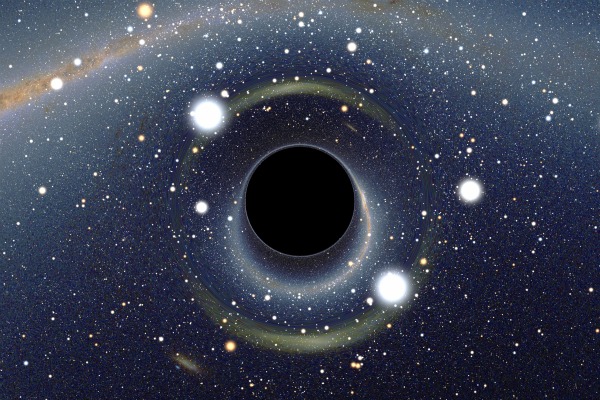Scientists Closing in on Black Hole at Center of Our Galaxy

Though scientists have suspected for a while that a giant black hole lurks at the center of our galaxy, they still can't say for sure it's the explanation for the strange behavior observed there. Now researchers are closer than ever to being able to image this region and probe the physics at work – potentially shedding light on the great conflict between the theories of general relativity and quantum mechanics.
At the heart of the Milky Way, astronomers see some wacky things. For example, about a dozen stars seem to be orbiting some invisible object. One star has been found to make a 16-year orbit around the unseen thing, moving at the hard-to-imagine speed of about 3,000 miles (5,000 kilometers) a second. By comparison, the sun moves through space at a comparatively glacial 137 miles (220 kilometers) a second.
Based on the laws of motion, these dozen stars' orbits should be caused by the gravitational pull of some massive object in the center of the galaxy. Yet telescopes observe nothing there.
"The really important thing is that all the orbits have a common focus," astrophysicist Mark Reidof the Harvard-Smithsonian Center for Astrophysics said during the recently concluded April 2012 meeting of the American Physical Society."There's one point on the sky, and there's nothing you can see on images at this position."
Plus, all this is happening in a region only about 100 times as wide as the distance between the Earth and the sun – very tiny in the galactic scheme of things. [Photos: Black Holes of the Universe]
There is, however, a very faint emission of radio waves coming from this area, which scientists call Sagittarius A* (pronounced "Sagittarius A-Star"). By comparing it against the sun's movement around the Milky Way, researchers have been able to determine that this object is barely moving at all – less than 1 kilometer (0.62 miles) a second, much slower even than the rate that the Earth revolves around the sun.
If Sagittarius A* were any moderate-mass object, it likely would be pulled by the gravity of nearby objects and experience some motion.
Get the world’s most fascinating discoveries delivered straight to your inbox.
Reid said of the object's apparent stillness: "The only way that this can happen is if Sagittarius A* is tied to a very massive object. When you do the analysis, you get a lower limit of 4 million solar masses."
The density limit of a black hole
Astronomers can't see the galactic center well enough to measure exactly how large Sagittarius A* is, but they can say for sure that its radius is no larger than about two-tenths the distance between the Earth and the sun.
The means that in the center of the Milky Way, something packing about 4 million times the mass of the sun is sitting within an area that could fit inside the orbit of Mercury and is basically invisible, producing much less light than any of the stars orbiting it.
Right now, that puts this object's density at about an eighth of the theoretical limit for a black hole. So while scientists can't say for sure the object is a black hole, it's looking mighty likely.
"Although there are alternative explanations, they would actually be even much more fantastic than the rather mundane supermassive black hole that almost certainly is there," Reid said.
One of these other, exotic explanations is that there exists a ball made of an unidentified variety of heavy fermion particles. But even such a ball would be unlikely to have the density required to explain all the evidence.
Looking closer
To finally solve this riddle, astronomers yearn to image the center of the galaxy directly. Not only is it very distant and faint, this region is hard to see because of all the dust between it and Earth.
Astronomers have recently begun a project called the Event Horizon Telescope. This instrument would integrate many radio observatories around the world, turning them into a giant interferometer capable of very precise measurements. Ultimately, the resolution should be sharp enough to distinguish Sagittarius A*.
So far, the Event Horizon Telescope has integrated only three observatories, in Hawaii, California and Arizona, for an observing time of between 15 and 20 hours. But astronomers hope to add more locations and observing time soon.
"EHT is not a dream, it's not on the drawing board," said Avery Broderickof Canada's University of Waterloo and the Perimeter Institute for Theoretical Physics."It's something that works."
One of Broderick's goals is not only determining once and for all if Sagittarius A* is a black hole, but probing the physics of the object.
Testing general relativity
Black holes straddle the two most successful theories of physics: one that describes the realm of the very large, and one that describes the province of the very small.
Black holes' extremely large masses invoke Einstein's general theory of relativity, which describes how mass warps the fabric of space and time to create gravity. But an explanation for black holes' extremely small spatial dimensions also requires quantum mechanics. [Images: The Big Bang & Early Universe]
So far, quantum mechanics and general relativity are incompatible. When combined to describe black holes, the equations break down and suggest that the density of a black hole is infinite.
Though the Event Horizon Telescope has produced only very preliminary data so far, Broderick and his colleagues have used them to test the space-time predictions of general relativity.
"Even with existing data today we can say something interesting about the higher-order structure of astrophysical black holes," Broderick said. "We will in principle be able to distinguish deviations from general relativity.
"General relativity is safe for right now, but it's not going to be safe for much longer."
This story was provided by SPACE.com, a sister site to LiveScience. You can follow SPACE.com assistant managing editor Clara Moskowitz on Twitter @ClaraMoskowitz. Follow SPACE.com for the latest in space science and exploration news on Twitter @Spacedotcom and on Facebook.


